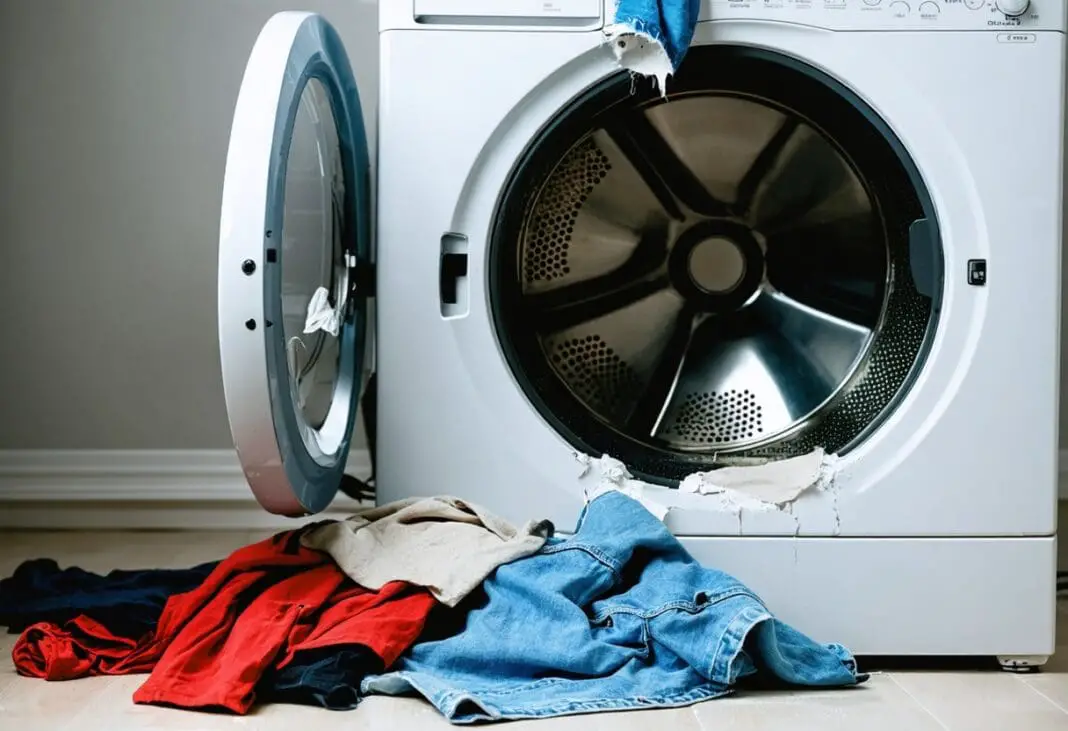Most people think their dryer can handle anything that survived the washing machine, but that assumption costs homeowners thousands of dollars every year in damaged clothes and broken appliances. The truth is, your trusty dryer has some serious limitations that manufacturers don’t exactly advertise on the front of the box. From melting expensive workout gear to starting actual fires, certain items can turn your helpful laundry companion into a destructive force that ruins everything it touches.
Your expensive bras will lose their shape permanently
That $60 bra from Victoria’s Secret wasn’t designed to withstand the intense heat and violent tumbling action inside your dryer. The delicate underwire, elastic bands, and cups get twisted and warped beyond repair when exposed to high temperatures. Even one trip through a hot dryer cycle can stretch out the band, making it loose and unsupportive forever. The underwire can also poke through the fabric after being bounced around, creating painful and unwearable undergarments that need immediate replacement.
Professional lingerie experts recommend laying all bras flat to dry, regardless of the material or price point. The same rule applies to other delicate undergarments like lace panties, shapewear, and anything with delicate straps or embellishments. Air drying might take longer, but it preserves the shape, elasticity, and structural integrity that keeps these items functional. Hanging them on a drying rack or laying them on clean towels ensures they maintain their original fit and support for years instead of months.
Swimsuits turn into see-through disasters
The spandex and lycra fibers that give swimsuits their stretchy, form-fitting properties become brittle and weak when exposed to dryer heat. What starts as a perfectly opaque bathing suit can develop thin spots and transparent areas after just one hot drying cycle. The elastic fibers literally break down at a molecular level, causing the fabric to lose its ability to snap back into shape. This means your swimsuit will become saggy, baggy, and embarrassingly see-through in all the wrong places.
The chlorine and salt water that swimsuits encounter during normal use already weakens these synthetic fibers over time. Adding intense dryer heat accelerates this breakdown process exponentially, turning a $80 designer bikini into unwearable fabric scraps. Instead, rinse swimwear in cool water immediately after use, then lay flat on a clean towel away from direct sunlight. This gentle drying method preserves the fabric’s stretch and color while preventing the premature aging that ruins so many expensive bathing suits every summer.
Workout clothes lose their moisture-wicking abilities
Those expensive Lululemon leggings and Under Armour shirts contain special synthetic fibers designed to pull sweat away from your skin and keep you comfortable during exercise. High dryer heat destroys these moisture-wicking properties by melting and reshaping the microscopic fiber structure that makes the technology work. Once damaged, these clothes will actually trap moisture against your skin instead of moving it away, making workouts uncomfortable and potentially causing skin irritation from prolonged contact with sweat.
The spandex content in most workout clothes also shrinks and becomes less flexible when exposed to high temperatures. This means your favorite yoga pants might become uncomfortably tight or restrictive after a few dryer cycles. The compression properties that provide muscle support during exercise get compromised as well, reducing the garments’ effectiveness for athletic activities. Air drying preserves both the technical performance features and the comfortable fit that makes activewear worth its premium price point.
Rubber-backed bath mats become safety hazards
The rubber backing on bath mats and area rugs starts cracking and crumbling when exposed to dryer heat, creating a mess inside your machine and rendering the mat unsafe for bathroom use. These rubber particles get stuck in your dryer’s lint trap and ventilation system, potentially causing mechanical problems that require expensive repairs. Worse yet, the crumbling rubber can transfer onto other clothes in the same load, leaving black specks and residue that’s nearly impossible to remove from fabric.
A bath mat with damaged rubber backing loses its primary safety function of preventing slips and falls on wet bathroom floors. The deteriorated backing can’t grip smooth surfaces properly, turning what should be a safety feature into a sliding hazard. Some rubber compounds can also create fire risks when heated to high temperatures in enclosed spaces. Always check the care label on bath mats and opt for air drying to preserve both their functionality and your dryer’s internal components.
Sequined and beaded clothes destroy everything
Those glamorous party dresses covered in sequins, beads, or metallic embellishments turn into destructive weapons when they start tumbling around in a hot dryer. The decorative elements can detach and scatter throughout the machine, scratching the drum walls and getting caught in moving parts. Even worse, loose sequins and beads can puncture or snag other garments in the same load, creating pulls, tears, and holes in clothes that were perfectly fine before the drying cycle started.
The glue or thread holding these embellishments in place often can’t withstand high heat, causing widespread decoration loss that ruins the garment’s appearance. What started as an elegant evening dress becomes a sad, partially-decorated piece of fabric with obvious bare spots where sequins used to be. The heat can also cause metallic elements to discolor or tarnish, permanently altering their appearance. Embellished clothing should always be laid flat on clean towels to dry, preserving both the decorative elements and protecting other laundry from damage.
Leather and faux leather crack beyond repair
Real leather contains natural oils that keep the material supple and flexible, but dryer heat causes these oils to evaporate rapidly, leaving behind stiff, cracked, and brittle material. Even brief exposure to high temperatures can cause irreversible damage that makes leather clothes unwearable and leather accessories unusable. Faux leather products suffer even worse damage because the synthetic materials can actually melt or warp when heated, creating permanent deformations that completely destroy the item’s shape and appearance.
Suede and other delicate leather finishes are particularly vulnerable to heat damage because their textured surfaces depend on specific fiber alignment that gets disrupted by tumbling and temperature extremes. Professional leather cleaning services exist specifically because these materials require specialized care that home appliances simply can’t provide safely. Leather items that accidentally go through the dryer usually need complete replacement because the structural damage makes them unwearable and potentially unsafe if the material has become weak enough to tear unexpectedly.
Wool sweaters shrink into doll clothes
Wool fibers have natural scales that lock together permanently when exposed to heat, moisture, and agitation simultaneously – exactly the conditions inside a clothes dryer. This process, called felting, causes the fibers to contract and mat together irreversibly, shrinking adult-sized sweaters down to child or even doll proportions. The transformation happens quickly and can’t be undone, turning expensive cashmere and wool garments into miniature versions that fit nobody in the household.
Even wool blends containing small percentages of natural fibers can shrink dramatically in the dryer, because the synthetic fibers can’t prevent the wool components from contracting. The texture also changes completely, becoming dense, stiff, and uncomfortable against the skin instead of soft and breathable. Wool sweaters should be reshaped while damp and laid flat on clean towels to dry, maintaining their original size and luxurious feel. This gentle drying method preserves the natural properties that make wool clothing comfortable and valuable.
Running shoes lose cushioning and support
The foam cushioning systems in modern running shoes are engineered to provide specific levels of support and shock absorption, but dryer heat causes these materials to break down and lose their protective properties. The adhesives holding different shoe components together can also fail when exposed to high temperatures, causing soles to separate from uppers or interior padding to shift out of position. Once this damage occurs, the shoes become uncomfortable to wear and potentially dangerous for athletic activities.
The synthetic mesh and fabric components in athletic shoes can shrink at different rates than rubber and foam parts, creating internal stress that leads to cracking, tearing, and structural failure. This uneven shrinkage also affects the shoe’s fit, making them too tight in some areas and too loose in others. Running shoes should be cleaned by hand and stuffed with newspaper or paper towels to maintain their shape while air drying. This method preserves both the performance features and the proper fit that makes athletic footwear effective and comfortable.
Items with paint stains create fire hazards
Clothing contaminated with paint, varnish, nail polish, or other chemical substances poses serious fire risks when placed in a hot dryer environment. These chemicals can ignite at relatively low temperatures, especially when concentrated in fabric fibers and exposed to the dryer’s heating elements and enclosed space. Even if the paint appears dry on the surface, volatile compounds can remain trapped in the fabric and become dangerously combustible when heated.
The tumbling action of the dryer can also cause paint flakes and chemical residues to spread throughout the machine, contaminating future loads and potentially damaging the appliance’s internal components. Professional fire safety experts recommend disposing of heavily contaminated items rather than attempting to clean them at home. For lightly stained clothes, thorough outdoor air drying allows chemical compounds to dissipate safely without creating enclosed fire hazards. Paint removal products should be used in well-ventilated areas, and treated items should always air dry completely before any heat exposure.
Understanding which items can safely go in the dryer protects both expensive clothing investments and prevents potentially dangerous situations in the home. When in doubt, checking care labels and choosing air drying methods preserves the quality, safety, and longevity of clothing while avoiding costly appliance repairs or replacements that result from improper use.

